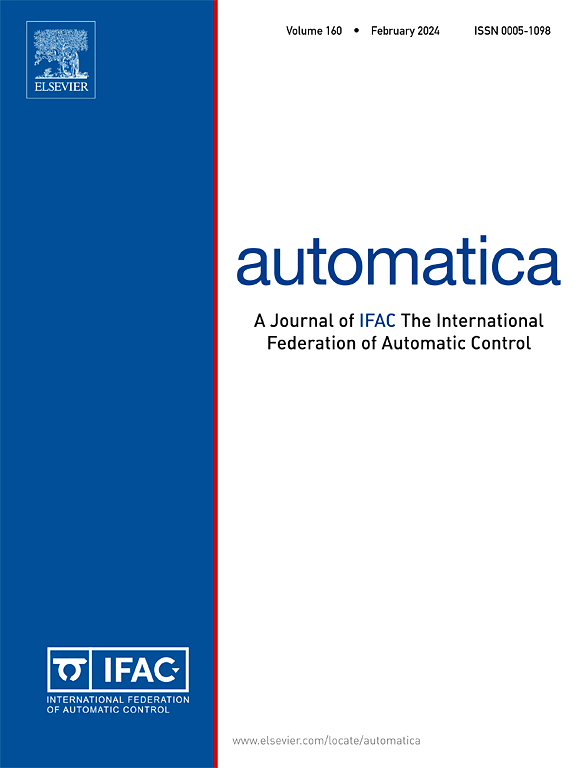Longitudinal and lateral control of vehicle platoons: A unifying framework to prevent corner cutting
IF 4.8
2区 计算机科学
Q1 AUTOMATION & CONTROL SYSTEMS
引用次数: 0
Abstract
The formation of platoons, where groups of vehicles follow each other at close distances, has the potential to increase road capacity. In this paper, a decentralized control approach is presented that extends the well-known constant headway vehicle following approach to the two-dimensional case, i.e., lateral control is included in addition to the longitudinal control. The presented control scheme employs a direct vehicle-following approach where each vehicle in the platoon is responsible for following the directly preceding vehicle according to a nonlinear spacing policy. The proposed spacing policy is motivated by an approximation of a delay-based spacing policy and results in a generalization of the constant-headway spacing policy to the two-dimensional case. By input–output linearization, necessary and sufficient conditions for the tracking of the nonlinear spacing policy are obtained, which motivate the synthesis of the lateral and longitudinal controllers of each vehicle in the platoon. By deriving an internal state representation of the follower vehicle and showing input-to-state stability, the internal dynamics for each leader–follower subsystem are shown to be well-behaved. Furthermore, the spacing policy results in string-stable behavior of the platoon when driving in the longitudinal direction. The results are illustrated by a simulation.
车辆排的纵向和横向控制:一个统一的框架,以防止切角
车队的形成,也就是车辆在近距离上相互跟随,有可能增加道路容量。本文提出了一种分散控制方法,将众所周知的恒时距车辆跟踪方法扩展到二维情况,即除了纵向控制外还包括横向控制。所提出的控制方案采用车辆直接跟随的方法,其中队列中的每辆车都有责任按照非线性间隔策略跟随前面的车辆。所提出的间隔策略是由基于延迟的间隔策略的近似驱动的,并将等车头时距策略推广到二维情况。通过输入输出线性化,得到了非线性间距策略跟踪的充分必要条件,激励了队列中每辆车的横向和纵向控制器的综合。通过推导跟随车辆的内部状态表示并显示输入-状态稳定性,每个领导-跟随子系统的内部动力学表现良好。此外,在纵向行驶时,间距策略还能保证排柱的稳定行为。仿真结果说明了本文的研究结果。
本文章由计算机程序翻译,如有差异,请以英文原文为准。
求助全文
约1分钟内获得全文
求助全文
来源期刊

Automatica
工程技术-工程:电子与电气
CiteScore
10.70
自引率
7.80%
发文量
617
审稿时长
5 months
期刊介绍:
Automatica is a leading archival publication in the field of systems and control. The field encompasses today a broad set of areas and topics, and is thriving not only within itself but also in terms of its impact on other fields, such as communications, computers, biology, energy and economics. Since its inception in 1963, Automatica has kept abreast with the evolution of the field over the years, and has emerged as a leading publication driving the trends in the field.
After being founded in 1963, Automatica became a journal of the International Federation of Automatic Control (IFAC) in 1969. It features a characteristic blend of theoretical and applied papers of archival, lasting value, reporting cutting edge research results by authors across the globe. It features articles in distinct categories, including regular, brief and survey papers, technical communiqués, correspondence items, as well as reviews on published books of interest to the readership. It occasionally publishes special issues on emerging new topics or established mature topics of interest to a broad audience.
Automatica solicits original high-quality contributions in all the categories listed above, and in all areas of systems and control interpreted in a broad sense and evolving constantly. They may be submitted directly to a subject editor or to the Editor-in-Chief if not sure about the subject area. Editorial procedures in place assure careful, fair, and prompt handling of all submitted articles. Accepted papers appear in the journal in the shortest time feasible given production time constraints.
 求助内容:
求助内容: 应助结果提醒方式:
应助结果提醒方式:


